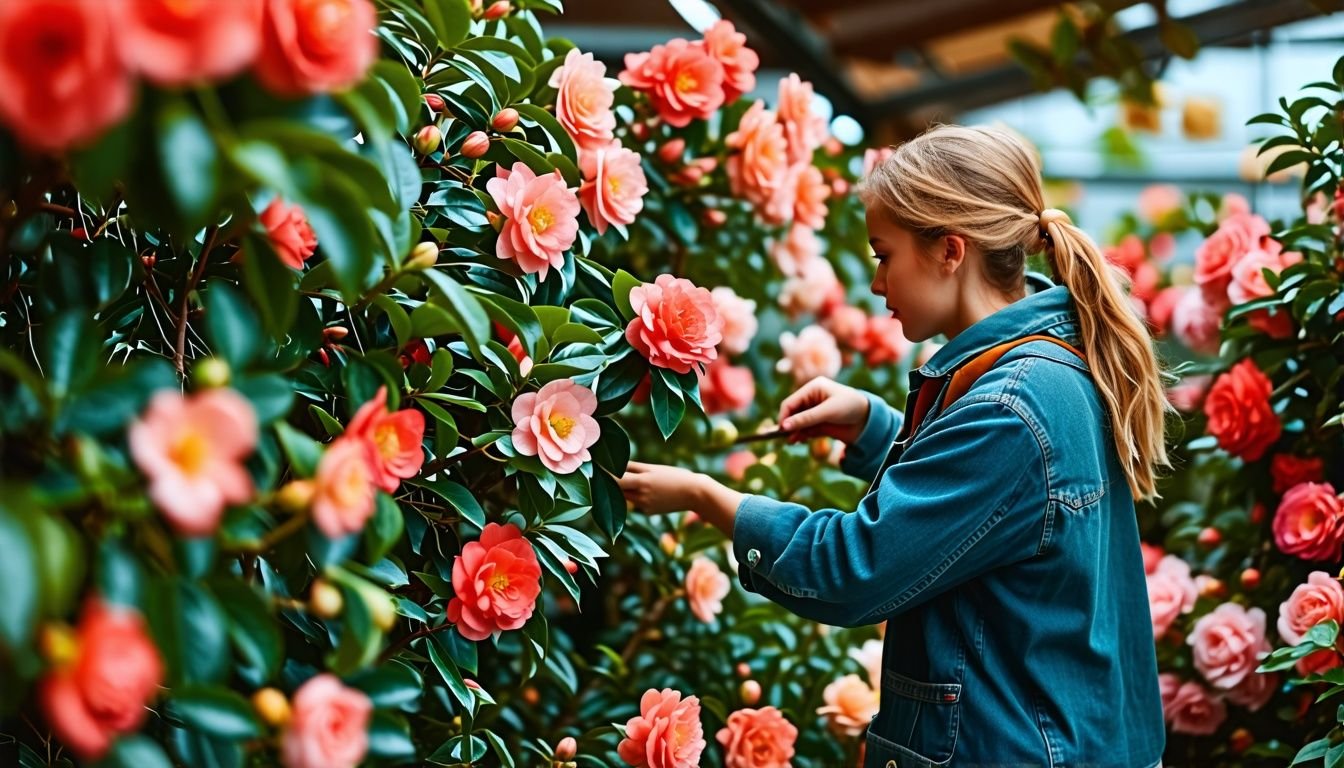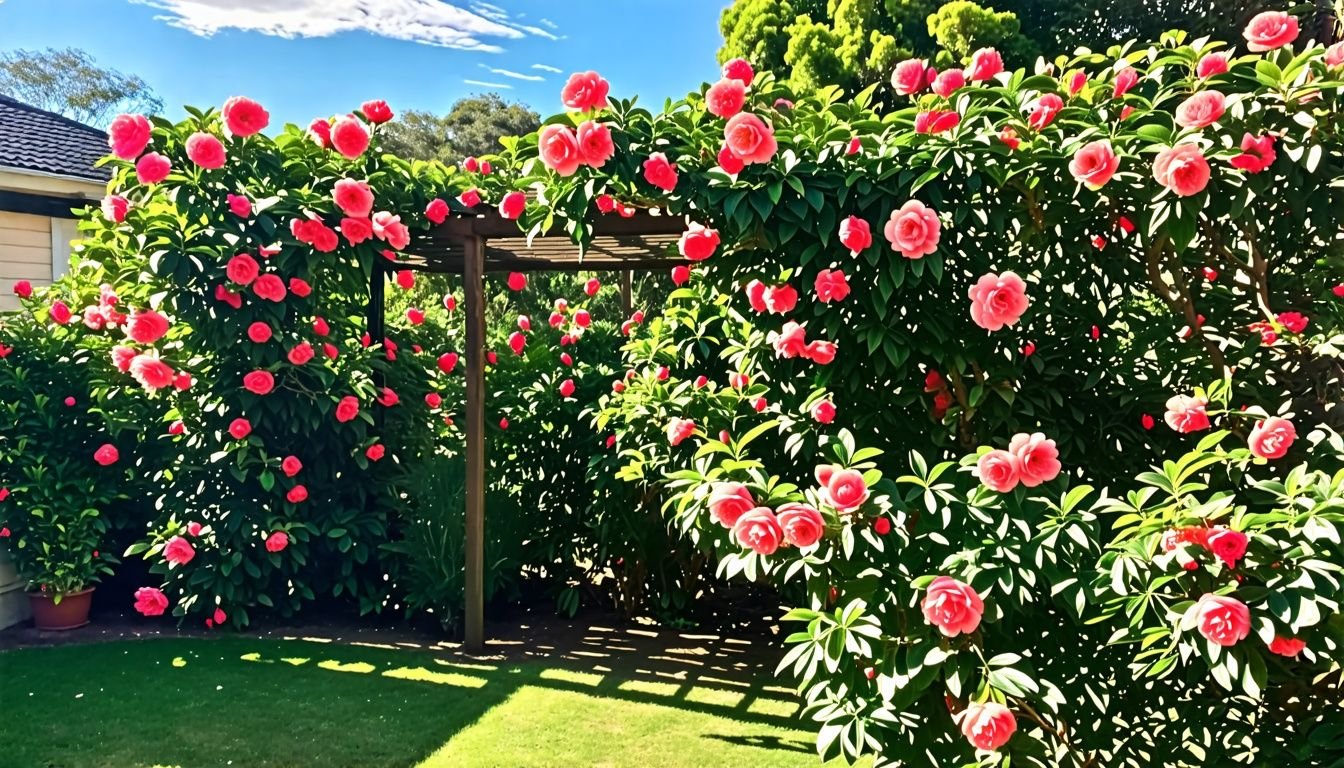G’day, fellow garden enthusiasts! Dreaming of a lush, green wall of flowers in your outdoor space? Too right, many Aussie gardeners struggle to find the perfect climbing plant for their trellises or fences.
It’s a fair dinkum challenge, searching for a versatile option that thrives in our varied climate. That’s when we stumbled upon the beauty of climbing camellias.
We’ve spent donkey’s hours researching and testing different camellia varieties in our own backyards. These stunning plants can be trained to grow as vines, adding a touch of elegance to any outdoor area.
Whether you’ve got a small courtyard or a sprawling backyard, climbing camellias are a ripper choice. They flourish in part shade and well-drained soil, making them ideal for many Australian gardens.
Our guide will show you how to select, plant, and care for these gorgeous climbers. Ready to transform your garden? Let’s give it a burl!
Key Takeaways
- Climbing camellias like ‘Jennifer Susan’ and Camellia japonica are bonza choices for Aussie gardens, thriving in part shade and well-drained soil.
- To train camellias as climbers, use espalier techniques with designs like V-shaped, Belgian fence, or palmette patterns, setting up posts and wires for support.
- Prune camellias after flowering in autumn or spring, and do regular tip pruning to encourage bushy growth and more blooms.
- Apply camellia fertiliser in early spring, mulch around the base, and water regularly to keep the soil moist for healthy plant growth.
- Clean your pruning tools between cuts with rubbing alcohol to stop diseases from spreading among your plants.
Selecting the Right Camellia Varieties for Climbing

Climbing camellias can transform your garden with their elegant blooms and lush foliage. We’ll guide you through choosing the best varieties for vertical growth. These hardy plants thrive in compact spaces and narrow beds, making them perfect for small gardens.
Camellia sasanqua ‘Jennifer Susan’
Camellia sasanqua ‘Jennifer Susan’ is a fantastic choice for Aussie gardens. We love this variety for its fast growth and sun-tolerant nature, making it perfect for espaliers. It’s a versatile plant that thrives in various climate zones, from arid to tropical.
‘Jennifer Susan’ boasts a compact shape, ideal for small courtyards or narrow garden beds. This beauty can reach heights of 1m to 5m, offering flexibility in design. Its flowers bloom from late summer to mid-winter, creating a stunning display.
The blossoms only last a day or two, but their brief appearance adds a touch of elegance to any space.
For those keen on floristry, ‘Jennifer Susan’ offers ample opportunities. Its branches can be pruned and shaped to suit your needs. We recommend using quality secateurs for this task.
Next, let’s explore another popular camellia variety for climbing.
Camellia japonica
Moving from the delicate ‘Jennifer Susan’ variety, we’ll now explore another popular climbing camellia: Camellia japonica. This species grows into a small tree and boasts flowers in various colours and petal arrangements.
We love C. japonica for its versatility in Australian gardens, thriving in multiple climate zones across the country.
Our team recommends planting C. japonica in spring or autumn for best results. It prefers partial to full shade, making it perfect for those tricky spots in your garden that don’t get much sun.
We’ve found this species to be quite hardy, adapting well to zones 7-9 and heat zones 7-8. For our fellow Aussie gardeners, C. japonica flourishes in climate zones 4 through 9, and 12 through 24.
To train C. japonica as a climber, we use techniques like espaliering or creating a belgian fence. These methods work well with the plant’s natural growth habits. We often use approach grafting to encourage vertical growth along our chosen support structure.
Regular pruning and the right potting mix help maintain the desired shape and promote healthy growth. Mulching around the base keeps the roots cool and moist, essential for this shade-loving plant.
Essential Techniques for Training Camellias as Vines
We’ve got some top tips for training your camellias to climb. These methods will help you create stunning vertical displays in your garden.
Choosing Your Espalier Design
Choosing the right espalier design for our climbing camellias is crucial. We’ve got plenty of options, from formal patterns like V-shaped, Belgian fence, horizontal T, and palmette designs to informal, whimsical serpentines.
Each style affects how our camellia grows and looks. For small Aussie gardens, espaliers are ace for maximising space.
Let’s consider our garden’s size and style when picking a design. Formal patterns suit structured landscapes, while free-form designs blend well with natural settings. We’ll need wires or lattice for support, and setting up two or more posts parallel to a wall works a treat.
Our choice will shape how we train our camellia, influencing its growth and overall appearance.
The art of espaliering transforms camellias into living sculptures, adding vertical interest to any garden.
Constructing Your Espalier Frame
We’re excited to share our tips on constructing an espalier frame for your climbing camellias. A sturdy frame is crucial to support the weight of your growing plant. We recommend setting posts parallel to the wall for optimal support.
This technique works well for both hedging and topiarying purposes.
Our experience shows that proper spacing is key. We apply ties every 20 cm to train the vines effectively. This method ensures even growth and a beautiful, structured appearance. As your camellia grows, you might need to make regular adjustments to the frame.
For the best results, we suggest using quality materials from trusted nurseries. Clean secateurs and a sharp budding knife are essential tools for this project. Don’t forget to grab some budding tape too.
With these supplies and our guidance, you’ll be well on your way to creating a stunning espaliered camellia display in your garden.
Maintenance Tips for Climbing Camellias
We’ll show you how to keep your climbing camellias thriving. Regular care and pruning are key to maintaining their health and shape as they grow up your garden structures.
Pruning and Plant Care
Pruning and plant care are crucial for maintaining healthy climbing camellias. Let’s explore some essential tips to keep our vines thriving.
- Prune after flowering: Trim our camellias in fall or spring after they’ve bloomed. This timing prevents damage to next season’s buds.
- Tip pruning: Regularly pinch off the tips of new growth. This encourages dense, bushy growth and more flowers.
- Shape maintenance: Cut back long, straggly branches to maintain the desired shape. This keeps our climbing camellias looking neat and tidy.
- Fertilise wisely: Apply camellia fertiliser after repotting or in early spring. This gives our plants the nutrients they need for healthy growth.
- Mulch application: Spread a layer of organic mulch around the base of our camellias. This helps retain soil moisture and prevents root drying.
- Water regularly: Keep the soil consistently moist, especially during dry spells. Proper watering is key to camellia health.
- Rootstock care: If our camellias are grafted, remove any shoots growing from below the graft union. This ensures energy goes to the desired variety.
- Disease prevention: Prune out any diseased or dead wood promptly. This stops the spread of potential issues to healthy parts of the plant.
- Tool hygiene: Clean our pruning tools between cuts with rubbing alcohol. This practice prevents the spread of diseases among our plants.
- Training support: As our camellias grow, gently tie new growth to the support structure. This guides the climbing habit we’re aiming for.
Conclusion
Growing climbing camellias as vines adds a unique charm to any garden. We’ve shared tips on choosing the right varieties and training techniques. These versatile plants offer beauty and flexibility for various garden styles.
With proper care, your camellia vines will thrive and bloom year after year. Give it a go and enjoy the stunning results in your own backyard!
FAQs
1. What are climbing camellias?
Climbing camellias are shrubs that can grow like vines. They have beautiful flowers and can cover walls or fences.
2. How do I train a camellia to climb?
Use supports like trellises or wires. Tie the main stems gently to these supports. Prune side branches to encourage upward growth.
3. What conditions do climbing camellias need?
They prefer partial shade and well-drained, acidic soil. Water them regularly, especially when young. Protect them from strong winds.
4. When is the best time to plant climbing camellias?
Plant them in autumn or early spring. This gives them time to establish roots before extreme weather. Avoid planting in hot summer months.
